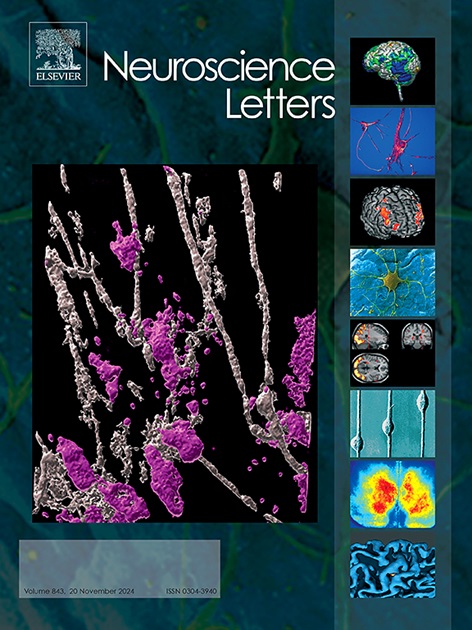Prenatal valproate exposure alters barrel cortex morphology in rats
IF 2
4区 医学
Q3 NEUROSCIENCES
引用次数: 0
Abstract
Autism Spectrum Disorder (ASD) is a neurodevelopmental condition influenced by genetic and environmental factors. Prenatal exposure to valproic acid (VPA) has been linked to morphological and behavioral abnormalities resembling ASD symptoms in humans. The whisker somatosensory system in rodents serves as an optimal model for studying ASD-related sensory alterations due to its well-defined modular and somatotopic organization. In this study, we analyzed whisker cortical maps in VPA-exposed rats using cytochrome oxidase histochemistry. Our results revealed significant alterations in the primary somatosensory cortex, including a reduction in total whisker map area and poorly defined cortical barrels. Additionally, some adjacent barrels exhibited fusion, and barrel row curvature was significantly reduced, suggesting disrupted somatotopic organization. These findings align with previous studies in genetic ASD models, such as Mecp2-knockout mice, which show reduced thalamocortical connectivity and structural changes in layer IV neurons. Moreover, recent research suggests that sensory deficits in ASD may also involve dysfunctions in the peripheral nervous system. Our study highlights the relevance of somatosensory cortical map alterations in environmentally induced ASD models. Further investigations into both central and peripheral nervous system contributions could provide valuable insights into the sensory deficits underlying ASD.
产前丙戊酸暴露改变大鼠桶皮质形态。
自闭症谱系障碍(ASD)是一种受遗传和环境因素影响的神经发育疾病。产前暴露于丙戊酸(VPA)与形态和行为异常有关,类似于人类的ASD症状。啮齿动物的须体感觉系统由于其明确定义的模块化和体位组织,成为研究asd相关感觉改变的最佳模型。在这项研究中,我们使用细胞色素氧化酶组织化学分析了vpa暴露大鼠的须皮层图谱。我们的研究结果揭示了初级体感觉皮层的显著改变,包括总须状图面积的减少和皮层桶的不明确定义。此外,一些相邻的桶表现出融合,桶排曲率显著降低,表明体位组织被破坏。这些发现与先前在遗传性ASD模型(如mecp2敲除小鼠)中的研究一致,后者显示丘脑皮质连通性降低,第四层神经元结构改变。此外,最近的研究表明,ASD的感觉缺陷也可能涉及周围神经系统的功能障碍。我们的研究强调了环境诱导的ASD模型中体感觉皮层图谱改变的相关性。对中枢和周围神经系统的进一步研究可以为ASD背后的感觉缺陷提供有价值的见解。
本文章由计算机程序翻译,如有差异,请以英文原文为准。
求助全文
约1分钟内获得全文
求助全文
来源期刊

Neuroscience Letters
医学-神经科学
CiteScore
5.20
自引率
0.00%
发文量
408
审稿时长
50 days
期刊介绍:
Neuroscience Letters is devoted to the rapid publication of short, high-quality papers of interest to the broad community of neuroscientists. Only papers which will make a significant addition to the literature in the field will be published. Papers in all areas of neuroscience - molecular, cellular, developmental, systems, behavioral and cognitive, as well as computational - will be considered for publication. Submission of laboratory investigations that shed light on disease mechanisms is encouraged. Special Issues, edited by Guest Editors to cover new and rapidly-moving areas, will include invited mini-reviews. Occasional mini-reviews in especially timely areas will be considered for publication, without invitation, outside of Special Issues; these un-solicited mini-reviews can be submitted without invitation but must be of very high quality. Clinical studies will also be published if they provide new information about organization or actions of the nervous system, or provide new insights into the neurobiology of disease. NSL does not publish case reports.
 求助内容:
求助内容: 应助结果提醒方式:
应助结果提醒方式:


